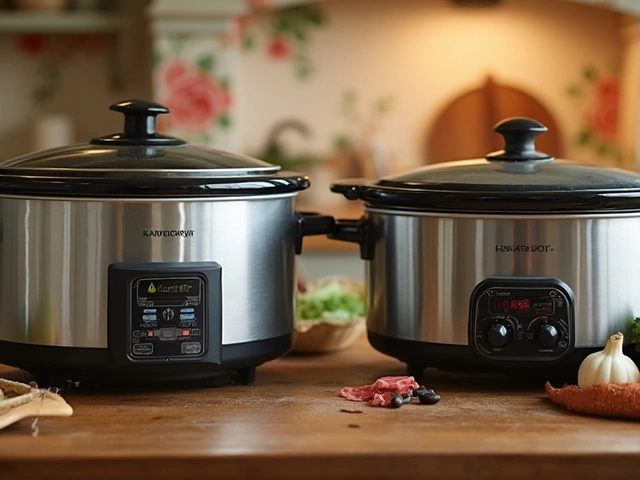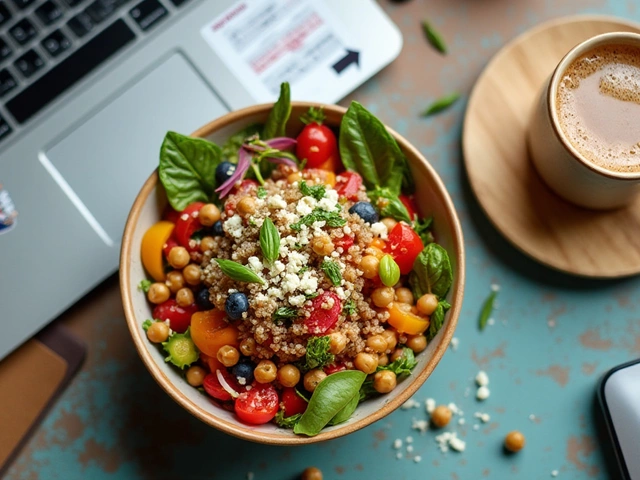
Ever checked your grocery receipt and wondered where it all went? You’re not alone. Setting a realistic food budget for two adults isn’t just about picking a number. Groceries can get expensive fast, especially if you’re not paying attention—or tossing random stuff in the cart because you’re hungry.
The average American couple spends anywhere from $500 to $800 a month on groceries, depending on where you live and how you shop. If you’re eating out a lot or buying lots of specialty products, the cost jumps fast. On the flip side, if you plan meals, buy basic ingredients, and skip most of the prepared stuff, you can keep it closer to the lower end.
Instead of guessing every month, getting a handle on your food spending starts with tracking what you actually eat and buy. Most people overspend when they don’t plan ahead—and then end up tossing extra food by the end of the week. That’s money in the trash.
- How Much Do Two Adults Typically Spend on Food?
- What Shapes Your Grocery Budget?
- Money-Saving Meal Ideas and Shopping Tips
- Common Pitfalls to Avoid
How Much Do Two Adults Typically Spend on Food?
If you want to get a straight answer, the truth is there’s a pretty big range for what two adults usually spend on groceries each month. Your numbers can swing a lot based on habits, location, and whether you eat out. But let’s cut straight to the national stats to put a real figure on it.
The USDA publishes updated food spending guidelines every month. For 2025, their numbers say a couple could expect to spend between $550 and $1,200 per month depending on spending level and food choices. Most people fall somewhere in the middle. Here’s a breakdown of different spending levels based on the USDA’s January 2025 report:
| Spending Plan | Monthly Cost (for 2 Adults, Age 19-50) |
|---|---|
| Thrifty | $550 |
| Low-Cost | $700 |
| Moderate | $870 |
| Liberal | $1,200 |
So if you eat mainly at home, keep meals simple, and avoid expensive extras, you can hang around the “thrifty” or “low-cost” range. If you pick up more brand names, convenience foods, or add lots of meat and treats, your food spending jumps up quick.
Location matters, too. People living in urban areas or on the coasts usually pay more for groceries. And if you’re shopping organic or specialty stores, it’s easy to hit the top end of the range. If you want to keep your food budget on track, just knowing these ballpark numbers helps so you’re not caught off guard at checkout.
Eating out, by the way, isn’t included in those USDA numbers. According to a Bankrate study last year, couples who eat out twice a week add about $200–$300 a month to their overall food spending. That’s huge if you’re watching every dollar.
What Shapes Your Grocery Budget?
There’s no magic number for every couple’s grocery bill. Your budget depends on more than just how much you eat. It’s shaped by what you eat, where you live, and how you shop. Here’s how the details break down:
- Location: Big city, small town, or somewhere in between? Groceries in San Francisco cost a lot more than in Des Moines. For example, USDA data from late 2024 shows that the same basket of groceries can cost up to 30% more in major urban areas than in smaller towns.
- Eating Habits: Love steak and berries or eat a lot of rice and beans? Meat, dairy, and fresh produce drive up costs. Sticking to pantry basics can shave a lot off your monthly total.
- Special Diets: Gluten-free, vegan, or keto foods? These often come with a higher price tag, with gluten-free products averaging 242% more than their regular counterparts, according to a 2022 Consumer Reports study.
- Shopping Frequency: Popping in for groceries every other day? You’re more likely to impulse buy. Planning one or two bigger trips a week helps people stick to their lists and avoid extra costs.
- Brand Choices: Store brands or name brands? Going with the store brand can save you about 25-30% on average, according to a 2023 Nielsen report.
To give you an idea how things stack up, check out this quick comparison of monthly grocery costs for two adults in different situations (based on USDA food plans from 2024):
| Budget Level | Monthly Cost (2 adults) |
|---|---|
| Thrifty | $540 |
| Low-Cost | $690 |
| Moderate | $860 |
| Liberal | $1,080 |
If you eat out a lot, don’t forget that restaurant meals usually cost about three times what you’d spend to make the same meal at home. Ready meals and snacks at the grocery store also pile up quickly; they tend to be 30-50% more expensive than making simple versions from scratch.
When it comes to shaping a food budget that works for you, keep these factors in mind. Tiny changes—like planning a few more meals or shopping with a list—can make a big difference.

Money-Saving Meal Ideas and Shopping Tips
Stretching your food budget doesn’t mean eating bland or boring meals. It just means thinking smart about what you buy and cook. There are real savings hiding in your grocery cart if you know where to look.
Let’s talk numbers first. According to the USDA in 2024, a “thrifty” meal plan for two adults can hit as low as $563 a month, while a “liberal” plan (more treats, name brands, or convenience foods) can go over $900. That’s a big gap—most people can land somewhere in the middle if they’re intentional.
| Approach | Average Monthly Cost (U.S., 2024) |
|---|---|
| Thrifty | $563 |
| Moderate | $742 |
| Liberal | $912 |
Want smarter meals for less? Here’s what works for most couples:
- Plan meals before shopping. Pick simple recipes using similar ingredients. If you buy a bag of carrots, soup one night and roasted carrots another keeps waste down and costs low.
- Buy in bulk—when it makes sense. Rice, beans, oats, and chicken thighs are usually much cheaper per pound in family packs or bulk bins. Just split them into smaller containers at home.
- Use your freezer. Double a recipe and freeze half, or freeze single portions of veggies, bread, or meat so nothing spoils.
- Don’t sleep on store brands. In blind tests, store brands often taste just as good as popular name brands and can be 15–30% cheaper. Try swapping one or two items a week.
- Check weekly ads and shop sales. If broccoli or boneless skinless chicken is on sale, find a recipe for it. Build your meals around what’s cheap, not what’s expensive this week.
- Skip most single-serve or ready-to-eat stuff. Pre-chopped fruit, granola bars, or frozen meals add up quick. Whole foods cost less and give you more versatility.
Here’s a quick look at real prices for affordable meal staples (based on June 2025 averages):
| Item | Average Price (U.S.) |
|---|---|
| 1 lb dried beans | $1.50 |
| 1 dozen eggs | $2.25 |
| Whole chicken (4 lbs) | $7.00 |
| Bag of rice (2 lbs) | $2.00 |
| Pasta (1 lb) | $1.30 |
If you need inspiration, theme nights work well: meatless Monday, taco Tuesday, pasta Wednesday. Rotating 7–10 easy recipes keeps it from getting old and keeps your shopping list tight.
"The biggest savings come from cooking at home using whole foods. Even simple meals like stir-fried veggies and rice beat takeout, both for your wallet and your health," says Michael Pollan, food journalist and author.
Don’t overlook little habits either. Eat leftovers for lunch or repurpose them into a new dinner (roast chicken becomes soup or tacos the next day). Apps like Too Good To Go can snag you discounted produce or bakery items too, especially in bigger cities.
Common Pitfalls to Avoid
Racking up a food budget that’s just too high? A lot of people fall into the same grocery traps over and over. Let’s break down what usually goes wrong and how to steer clear.
- Shopping Without a List: Roaming the aisles with no plan is a classic mistake. Impulse buys trash your budget and end up as fridge science experiments. People who make a detailed list based on meals for the week spend up to 25% less, according to a Nielsen survey.
- Falling for Bulk Bargains: Buying giant packs might seem like a steal, but it’s only a deal if you’ll actually use them before they spoil. Think twice before tossing that family-size spinach into your cart unless you’re sure you’ll eat it all.
- Not Checking the Pantry First: Most of us already have hidden ingredients at home. Double-buying staples like rice, beans, or canned tomatoes means you’ll end up with enough for a small army. Always take a quick pantry snapshot before you head out.
- Relying on Takeout or Ready Meals: Easy, sure—but the costs skyrocket fast. The USDA reports households that eat prepared foods and takeout more than twice a week can spend almost double compared to home-cooked meals.
- Forgetting to Track Food Waste: Americans throw out about 30% of the food they buy. That’s not just bad for the planet—it’s real cash you’re tossing out. Freeze extras, use leftovers, and be honest about how much you’ll actually cook each week.
| Pitfall | Avg. Wasted Money/Month |
|---|---|
| Grocery Impulse Buys | $50 - $80 |
| Unused Bulk Purchases | $20 - $40 |
| Takeout & Ready Meals | $60 - $150 |
| Food Waste | $75 - $100 |
If you avoid these common traps, you’ll see more money stay in your pocket—and a lot less guilt over wasted groceries.





